Simple and tasty recipes for pickling cauliflower for the winter
Today, winter dishes made from cauliflower are not as widespread as those made from white cabbage. Nevertheless, due to its saturation with useful substances, during the cold season this vegetable fully compensates for the lack of vitamins in the body. Find out how to pickle cauliflower in jars for the winter in our article.
Selection and preparation of cauliflower for pickling
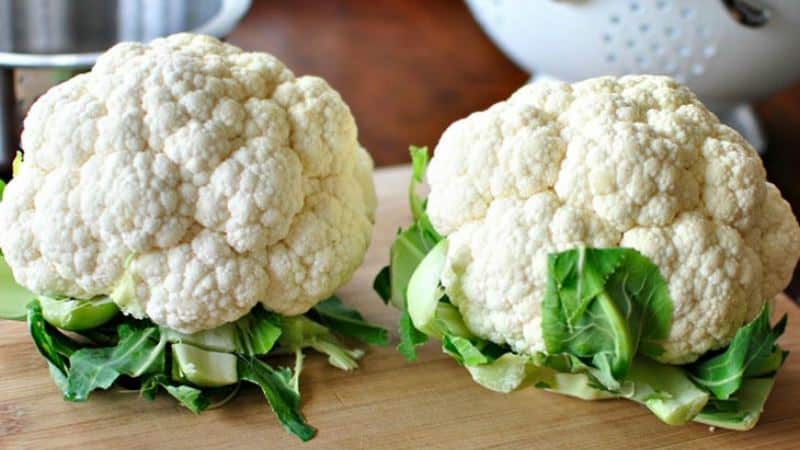
For canning, it is important to choose the freshest vegetables possible. A number of signs indicate the quality of a product:
- white or cream shade;
- uniform color regardless of variety;
- tight fit of inflorescences to each other;
- the elasticity of not only the heads of cabbage, but also the remaining parts (leaves, stem);
- ratio of weight and size - large and too light vegetables indicate that chemicals were used in their cultivation;
- absence of plaque, all kinds of dirt, mechanical damage, and stains of unknown origin on the surface.
Preparing vegetables for pickling includes thorough washing and eliminating possible insects. To do this, the product is first placed in salt water for 30 minutes, then washed under running cold water.
Important! Sometimes in stores you can find bright green inflorescences. This feature is not considered a deviation.
How to pickle cauliflower correctly in the classic way
There are many different recipes for pickling this vegetable crop, differing from each other in composition and specific preparation.The main advantage of the traditional option is affordable products and ease of execution.
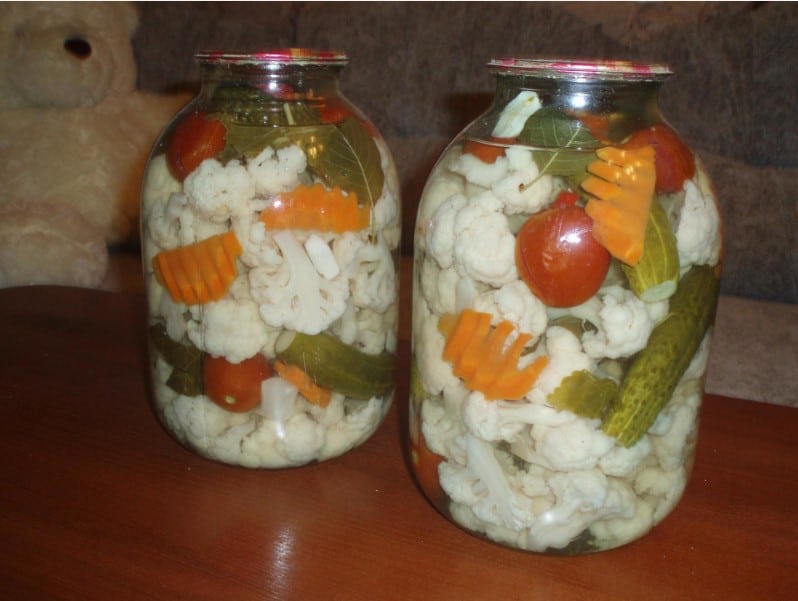
Ingredients and proportions
To obtain salting you will need:
- 3 kg of colored inflorescences;
- ¼ tbsp. table salt;
- ½ kg carrots;
- 1 liter of water;
- greens: bay leaf, celery, dill and tarragon - to taste.
Step-by-step instruction
Procedure:
- Disassemble the head of cabbage into several small pieces and keep in boiling water for 2 minutes until they soften.
- Cut the carrots into circles and combine with cabbage.
- Place salt in water, boil the solution, then leave to cool.
- Sterilize the jars and place tarragon and bay leaves in them.
- Fill the containers with the vegetable mixture and place the rest of the greens on top.
- Pour brine over the workpieces and roll up the lids.
Recipe Variations
Preservation from cauliflower – an ideal solution for those who want to add variety to the standard menu of tomatoes and cucumbers.
Instant cooking
Prepared this way winter dish will be ready for use in 3 days. The pickling has a rich taste and bright appearance due to the vegetables it contains.
Components:
- 1.5 kg of inflorescences;
- 120 g salt;
- 150 g sugar;
- 1 carrot;
- 1 beet;
- 12 peas each of black and allspice;
- 3 cloves of garlic;
- 1.5 liters of water.
Preparation:
- Divide the washed head of cabbage into several parts.
- Grate peeled and washed beets and carrots.
- Mix the vegetables and place in a prepared container.
- Finely chop the garlic and add to the rest of the ingredients.
- Pour sugar, pepper and salt into water and boil.
- Fill the workpiece with brine.
In Armenian
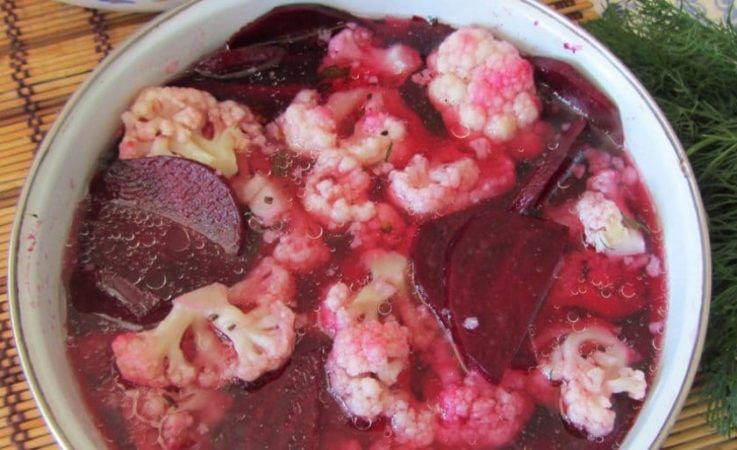
Components:
- 4 kg of inflorescences;
- 10 bay leaves;
- 3 beets;
- 1.5 carrots;
- 3 hot peppers (chili);
- 2 cloves of garlic;
- 1 horseradish root;
- several branches of dill and parsley;
- 2 tbsp. l.salt;
- black peppercorns (to taste).
Preparation:
- Prepare containers for preservation: wash, sterilize.
- Divide the cabbage into florets.
- Cut the vegetables into large pieces, chop the greens.
- For the marinade, dissolve 2 tbsp in boiling water. l. salt and cool the liquid to approximately 40°C.
- Place all the ingredients in a container in layers, sprinkle with spices.
- Pour the marinade into the vegetables, covering all layers.
- Cover the workpiece and place it in a warm room for a week, pressing down with pressure.
- Upon expiration of the due date, transfer to storage in a dark and cool place.
As a container for cooking in Armenian a small bucket, jar, plastic container or bulky kitchen utensil can be used; any container filled with water can be used as a pressure.
In Georgian
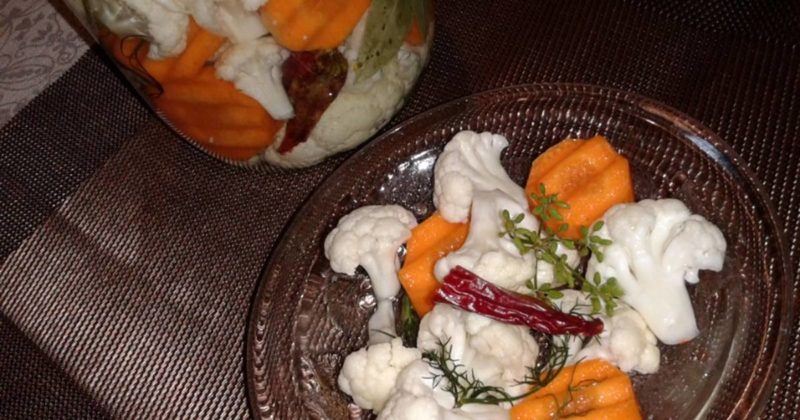
Ingredients:
- 1 small inflorescence;
- 4 beets;
- 50 g salt;
- 2 carrots;
- 10 cloves of garlic;
- 100 ml oil (preferably refined);
- 1 tbsp. Sahara;
- 1 tbsp. l. pepper (black);
- 5 bay leaves;
- 150 ml table vinegar (9%);
- 2 liters of purified water.
Preparation:
- Disassemble the cabbage into several parts, add salt and let stand for about 2 hours.
- Boil the beets and then chop them into strips together with the carrots.
- Place the ingredients in layers in the following order: beets, bay leaves, garlic, inflorescences, carrots. Then repeat until the container is full.
- Place vinegar, oil, salt and sugar in water, boil and continue cooking for 3-4 minutes.
- Fill the contents of the jar with warm brine and transfer to the cold.
In Korean
Ingredients:
- 1 kg of inflorescences;
- 2 carrots;
- 2 sweet peppers;
- 2 garlic heads;
- ½ tsp each spices: cardamom, cloves (ground), black pepper, nutmeg;
- 650 ml water;
- 1 hot pepper;
- 1 tbsp. l. coriander;
- 100 g each of vinegar, vegetable oil and sugar;
- 1.5 tbsp. l. salt.
It is possible to replace these spices with classic Korean seasoning; in this case, adjust the amount of hot pepper.
Preparation:
- Boil the cabbage for about 2 minutes.
- Combine the inflorescences with pepper, carrots, garlic and spices.
- Place the mixture into a sterilized container.
- Prepare marinade: Dilute vinegar, salt, butter and sugar in water, then boil and cook for 3-4 minutes.
- Fill the contents of the jar with brine and close the lid tightly.
With tomato
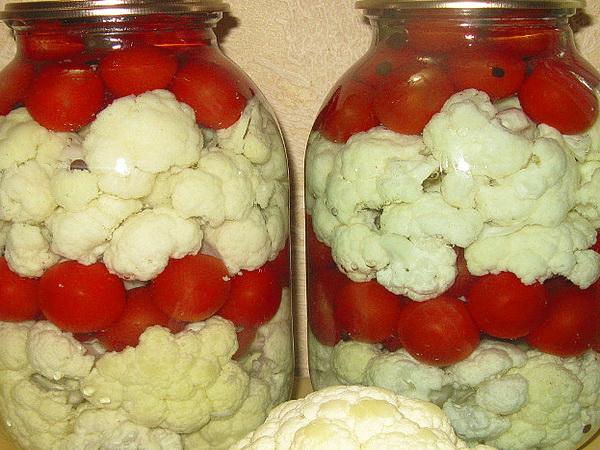
Ingredients:
- 1 cabbage inflorescence;
- 3 tomatoes;
- 1.5 tbsp. l. coarse salts;
- 1 liter of water;
- 3 tbsp. l. Sahara;
- 2 clove buds;
- 1 tsp. vinegar essence;
- 3 peppercorns each - allspice and black;
- 2 cloves of garlic;
- 2 bay leaves.
Preparation:
- Separate the cabbage into florets.
- Wash the tomatoes, dry them and pierce them in the stem area with a wooden skewer or fork. This will prevent the skin from cracking when in contact with boiling water.
- Place vegetables in sterilized jars, shake to seal the filling, then pour boiling water over them.
- Cover the containers with lids and leave for 30 minutes in a water bath.
- After the time has passed, drain the water, add spices and chopped garlic into rings.
- Prepare the marinade: pour water into a small saucepan, then dissolve sugar and salt in it and boil for 7 minutes over low heat. Then add vinegar (the spiciness of the vegetables will depend on the amount of this component).
- Pour the prepared brine over the pickles, close the lids and place them in a cool place for storage.
With beets and carrots
Ingredients:
- 1.5 cauliflower inflorescences;
- 10 garlic cloves;
- 1 beet;
- 1 carrot;
- 150 ml table vinegar (9%);
- ½ tbsp. vegetable oil;
- ½ tbsp.Sahara;
- 2 tbsp. l. salt;
- ½ tbsp. l. hot pepper;
- 1 tbsp. l. paprika;
- 1 liter of water.
Preparation:
- Divide the inflorescences into several parts.
- Grind the peeled carrots and beets.
- Coarsely chop the garlic.
- Boil water, cool slightly and dissolve butter, sugar, vinegar and salt in it.
- Place prepared cabbage, beets, carrots, and garlic in a container. Sprinkle each layer with pepper.
- Pour the prepared brine over the workpiece and refrigerate for 7 days.
After a week, the cabbage will acquire a rich pink color, pleasant spiciness and release juice.
With celery
Components:
- 1 kg cabbage;
- 1 liter of water;
- 30 g salt;
- 1 celery.
Preparation:
- Wash, peel and dry vegetables.
- Cut the celery into thin slices.
- Divide the cabbage into several florets.
- Soak the vegetables in cool water for 30 minutes, then let them dry and place them in a sterilized container.
- Add salt to boiling water and cook for 5 minutes.
- Pour the resulting marinade over the vegetables, close the preparations with lids and, when they have cooled, transfer them to storage in a cool and dark place.
In the recipe for cauliflower with celery, all components almost completely retain their beneficial qualities.
With zucchini
Components:
- 1 kg of inflorescences;
- 3 sweet peppers;
- 1 kg of young zucchini;
- 2 carrots;
- a bunch of dill;
- 1 head of garlic;
- 2 leaves of horseradish;
- 1 tbsp. l. salt;
- 50 ml vinegar (6%);
- 2 tbsp. l. Sahara;
- 6 bay leaves;
- peppercorns (allspice and black) - to taste.
Preparation:
- Keep the cabbage divided into inflorescences in boiling water for 2 minutes.
- Wash the zucchini and carrots and cut into circles.
- Cut the sweet pepper into slices.
- Finely chop the garlic and herbs.
- Before adding vegetables, be sure to sterilize the container.
- Place garlic and herbs at the bottom of the jar, lay out zucchini and cabbage in layers, sprinkling them with carrot slices and spices.
- Boil water and pour over the preparations, covering with lids. Leave the vegetables to warm up for 20 minutes.
- Drain the water from the jars and boil, then dissolve vinegar, sugar and salt in it.
- Fill the containers with prepared brine and roll up with metal lids.
After complete cooling, the containers are removed for storage.
Crispy Cauliflower with Vinegar
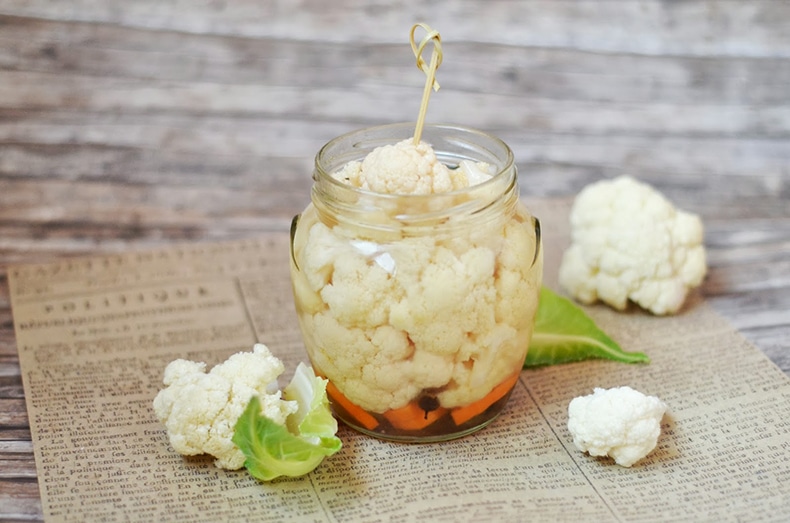
Components:
- 1 kg of inflorescences;
- 2 chili peppers;
- 2 tbsp. l. Sahara;
- 2 bell peppers;
- 1 liter of water;
- 4 bay leaves;
- 1 tbsp. l. salt;
- 3 cloves of garlic;
- 1 tbsp. l. (9%) vinegar.
Preparation:
- Divide the head of cabbage into inflorescences.
- Place bay leaf, chopped garlic and hot pepper on the bottom of the containers.
- Fill the jars to the top, alternating cabbage and bell peppers.
- Pour boiling water over the appetizer, cover with lids and leave to warm for 15 minutes.
- Pour water from the cans into a saucepan, bring its volume to 1 liter, add sugar and salt, boil and cook for 3 minutes. Pour vinegar into the marinade.
- Pour the prepared filling into containers and close them with lids.
- Turn the pieces upside down, cover and leave until cool. Then transfer to cold storage.
Terms and conditions of storage of blanks
The shelf life of canned cabbage is not limited, provided that a hot marinade was used during the cooking process and the containers are properly sealed with lids. The storage room should be dark and cool.
Important! Storage of blanks under nylon covers is possible for no more than 6 months.
Advice from experienced housewives
When preparing winter pickles from cauliflower, you should follow several rules developed based on many years of experience:
- do not divide the inflorescences into too small parts, otherwise they will quickly boil;
- be sure to turn the jars over after sealing and wrap them well - this will allow you to check the lids for leaks;
- Do not allow the cabbage to be overcooked, otherwise the product will not only lose its crunch, but also turn into porridge.
Conclusion
Canned cauliflower will be a godsend in the winter. If you follow the cooking rules, you will get not only a tasty, but also a very healthy dish, and adding your favorite ingredients to the recipe will make each pickling unique.